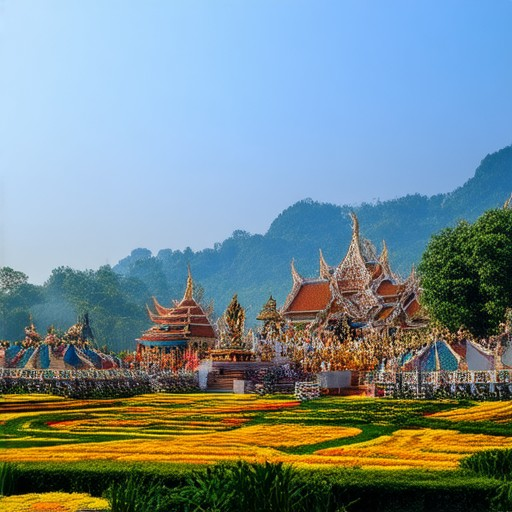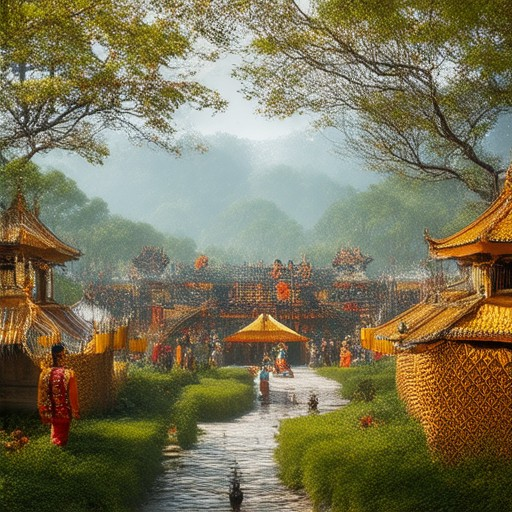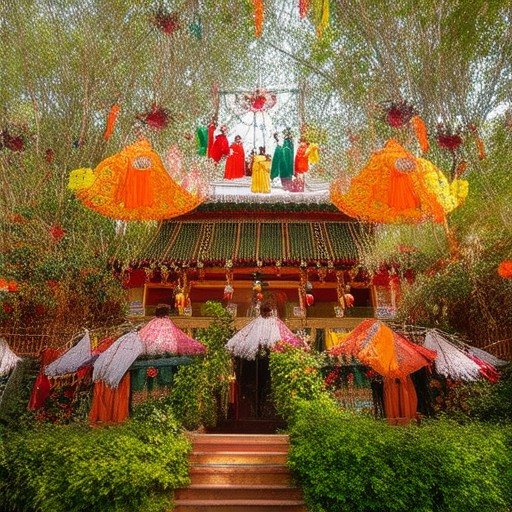Exploring the rich tapestry of human existence through travel is a journey that transcends mere geographical exploration. It is an immersive experience that delves into the heart of cultural diversity, offering insights into the unique narratives each destination holds. From ancient traditions to modern innovations, every location whispers stories that shape our understanding of the world. Travel isn’t just about visiting places; it’s about fostering empathy, appreciation, and a broader perspective on humanity. By embracing the opportunity to engage with diverse cultures, we unlock a deeper connection to our shared heritage and the endless possibilities of human expression. This journey of discovery isn’t just transformative for the individual but enriches our collective understanding, paving the way for a more compassionate and inclusive global community. How does this profound experience reshape our views? What hidden worlds await those willing to embark on this cultural odyssey?
Key Takeaways
– Top Destinations for Cultural Immersion: Explore rich cultural experiences in countries like Japan, India, China, Thailand, Europe, Africa, South America, the Middle East, and Oceania, each offering unique history, tradition, and modernity.
– Cultural Sensitivity Tips: Approach travel with empathy, respect, and an open mind. Research local customs, learn basic phrases, and engage respectfully with locals to foster understanding and connection.
– Dark Travel for Unique Perspectives: Delve into history’s darker sides through visits to cemeteries, battlefields, concentration camps, and ghost towns, offering intense experiences that transform your view of history and humanity.

How Does Traveling Help You Learn About Culture?
Traveling is a powerful tool for cultural education, offering immersive experiences that go beyond textbooks or lectures. Here’s how it enhances cultural understanding:
Exposure to Diverse Lifestyles
When you travel, you’re introduced to different lifestyles, traditions, and daily routines. Whether it’s trying local cuisine, participating in festivals, or observing community interactions, these experiences provide insight into how people live differently.
Understanding History Through Place
Traveling allows you to connect with historical contexts by seeing landmarks and locations where significant events occurred. This tangible connection helps bring history to life and deepens your appreciation for cultural evolution over time.
Building Resilience and Adaptability
Stepping outside your comfort zone in a foreign environment fosters resilience and adaptability. You learn to navigate unexpected challenges, communicate effectively in new languages, and embrace diversity, all of which contribute to personal growth.
Gaining Problem-Solving Skills
Traveling often requires quick thinking and resourcefulness. From figuring out transportation to solving cultural misunderstandings, these experiences sharpen your ability to think critically and find solutions in dynamic situations.
Fostering Empathy and Open-Mindedness
Engaging with locals and understanding their perspectives broadens your empathy. This emotional intelligence helps you develop a more open-minded view of the world, reducing cultural biases and promoting mutual respect.
Connecting with Global Perspectives
Traveling gives you a firsthand look at global perspectives, traditions, and values. By exploring different regions, you gain a broader understanding of human diversity and the unique ways communities shape their identities.
For deeper insights into cultural exploration, visit Bending Borders , a platform dedicated to sharing travel stories and global perspectives.
Exploring Cultural Diversity: A Comprehensive Guide
To truly understand and appreciate cultural diversity, one must embark on a journey that transcends borders and opens up to the rich tapestry of human experiences. Here’s a detailed approach to effectively explore and celebrate cultural differences:
1. Educate Yourself Through Research
Start by delving into books, academic journals, and reputable online resources that specialize in cultural studies. Websites like Bending Borders offer in-depth insights and real-life stories from around the globe. By understanding the history, traditions, and daily life of various cultures, you gain a deeper appreciation for their uniqueness.
2. Engage in Immersive Experiences
Traveling to different regions allows you to firsthand experience cultural norms, traditions, and lifestyles. Attend local festivals, try authentic cuisine, and interact with indigenous communities. This hands-on approach provides a vivid understanding of how people live in diverse settings.
3. Participate in Cultural Events and Workshops
Attend cultural festivals, art exhibitions, and workshops hosted by organizations dedicated to preserving diverse traditions. Platforms like Bending Borders Events often feature workshops on traditional crafts, music, and dance, offering a chance to engage deeply with cultural practices.
4. Connect with Global Networks
Join online forums, social media groups, and international organizations focused on cultural exchange. Platforms such as Bending Borders Community connect individuals passionate about sharing and learning from different cultures, fostering meaningful connections across borders.
5. Explore Virtual Reality and Interactive Media
Utilize virtual reality tools and interactive media to experience cultural environments remotely. Platforms like Bending Borders Technology offer cutting-edge experiences that simulate living in different cultural contexts, providing a unique perspective on diversity.
6. Learn a New Language or Skill
Languages and traditional skills, such as cooking or crafting, are gateways to understanding cultural identity. Enroll in language classes or workshops offered by institutions like Bending Borders Education to bridge cultural gaps through shared experiences.
7. Collaborate and Share Your Journey
Participate in collaborative projects or initiatives that promote cultural exchange. Share your own cultural journey through blogs, videos, or podcasts. Platforms such as Bending Borders Creation encourage creators to showcase their work, fostering dialogue and understanding.
8. Stay Curious and Open-Minded
Cultural exploration is an ongoing process. Stay curious, open-minded, and willing to adapt your perspective. Approach every interaction and experience with empathy and respect, recognizing the value of diverse viewpoints.
By embracing these approaches, you not only explore cultural diversity but also contribute to building a more inclusive and harmonious world. Remember, the journey begins with a single step, and every experience enriches our collective understanding of humanity.

Experiencing a New Culture Authentically While Traveling
To truly immerse yourself in a new culture while traveling, consider the following strategies:
- Research Local Customs and Etiquette: Begin by learning basic customs, such as greeting practices and social norms, to avoid misunderstandings. This simple step can significantly enhance your cultural experience.
- Engage with Locals: Break the ice by striking up conversations. Even with limited language skills, gestures and smiles can foster connections. Consider visiting local markets or joining community events to interact with residents.
- Participate in Local Activities: Immerse yourself by joining cooking classes, attending festivals, or visiting museums. These experiences offer insights into traditions and daily life.
- Volunteer or Join Community Projects: Volunteering provides a meaningful way to connect with locals and gain deeper insights into their values and routines. Look for opportunities through tourism boards or online platforms.
- Stay with a Local Family or Homestay: Experience authentic living by staying with a local family. This offers a chance to share meals, learn traditions, and integrate into their daily routine.
- Explore Hidden Gems: venture beyond tourist hotspots to discover local neighborhoods and hidden treasures. These areas often offer more authentic experiences and unique sights.
- Attend Local Events and Festivals: Participating in cultural events or festivals allows you to witness traditions firsthand. Check local calendars to time your visit appropriately.
- Learn from Locals: Enroll in workshops or classes taught by locals. This interactive approach helps you gain practical skills and a deeper appreciation for their crafts or expertise.
- Respect Privacy and Boundaries: Be mindful of personal space and cultural norms. Sometimes, locals may prefer solitude, so adjusting your approach with empathy is key.
- Sustainable Exploration: Support local sustainability by carrying reusable items and purchasing from artisan markets. This aligns with eco-conscious travel practices.
- Be Mindful of Cultural Differences: Observe and adapt to local greetings and body language. Understanding these nuances helps you navigate social interactions more effectively.
- Document Thoughtfully: Capture moments through photography or journaling, ensuring respect for privacy and cultural sensitivity.
- Reflect and Grow: After your journey, reflect on what you’ve learned. Apply these insights to foster cross-cultural understanding and appreciation in future endeavors.
By integrating these strategies, you can create meaningful and authentic cultural experiences during your travels, enriching both your journey and the communities you visit.

Where to Travel for the Most Cultural Experience
Exploring a destination that offers rich cultural experiences can be a transformative journey. Here are some top global hotspots renowned for their cultural vibrancy:
- Asia:
- Japan: Immerse yourself in the serene beauty of Kyoto’s temples, the vibrant streets of Tokyo, and the symbolic cherry blossoms.
- India: Experience the colorful festivals of Jaipur, the spiritual essence of Varanasi, and the architectural marvels of Delhi.
- China: Discover the historical wonders of the Great Wall and the ancient city of Xi’an, along with the dynamic energy of Shanghai.
- Thailand: Explore the sacred temples of Bangkok, the lush jungles of Chiang Mai, and the vibrant street markets of Pattaya.
- Europe:
- Italy: Visit the artistic masterpieces of Florence, the historical richness of Rome, and the romantic canals of Venice.
- Spain: Enjoy the lively festivals of Madrid, the architectural grandeur of Barcelona, and the iconic works of Gaudi.
- France: Experience the high fashion of Paris, the culinary delights of Lyon, and the charming villages of Provence.
- Germany: Discover the festive charm of Berlin’s Christmas markets, the medieval castles of Bavaria, and the historical legacy of Hamburg.
- Africa:
- Kenya: Embark on a safari adventure in the Maasai Mara, witness traditional music performances, and explore the Swahili architecture of Mombasa.
- South Africa: Visit the vibrant markets of Cape Town, the historical sites of Johannesburg, and the game reserves of Kruger National Park.
- South America:
- Brazil: Experience the Carnival festivities in Rio de Janeiro, the colonial charm of Salvador, and the Amazonian biodiversity of Manaus.
- Argentina: Enjoy the tango performances in Buenos Aires, the wine country of Mendoza, and the stunning landscapes of Patagonia.
- Peru: Explore the Incan ruins of Machu Picchu, the historical capital of Lima, and the colorful markets of Cusco.
- Middle East & North Africa:
- Jordan: Visit the archaeological wonder of Petra, the historical sites of Amman, and the beautiful beaches of Aqaba.
- Morocco: Discover the medinas of Marrakech, the Sahara Desert experiences, and the vibrant culture of Fes.
- Oceania:
- Australia: Explore the Aboriginal cultural sites of Uluru, the vibrant arts scene of Melbourne, and the natural beauty of the Great Barrier Reef.
- New Zealand: Witness the stunning landscapes of Queenstown, the cultural heritage of Rotorua, and the urban energy of Auckland.
Each of these destinations offers a unique blend of history, tradition, and modernity, making them ideal for those seeking a profound cultural experience. From savoring local cuisines to participating in traditional festivals, these locations promise unforgettable memories and a deeper connection with their cultural essence.
How Do You Become a Culturally Sensitive Traveler?
To become a culturally sensitive traveler, it’s essential to approach your journey with empathy, respect, and an open mind. Here’s a guide to help you navigate cultural differences effectively:
1. Understand Cultural Differences
- Research the local customs, traditions, and social norms of your destination.
- Learn basic phrases in the local language to show effort and respect.
- Be mindful of non-verbal cues, such as body language and facial expressions.
- Understand that cultural practices may differ significantly from what you’re accustomed to.
2. Prepare Thoroughly Before Travel
- Study the history and culture of your destination to gain deeper insights.
- Familiarize yourself with local etiquette and social expectations.
- Check for any specific dress codes or behavioral guidelines in religious or cultural sites.
- Plan your activities around local events or festivals to immerse yourself in the culture.
3. Show Respect and Sensitivity
- Avoid making assumptions about people based on their appearance or background.
- Be respectful of religious beliefs and practices, especially in sacred spaces.
- Ask questions when unsure about appropriate behavior or customs.
- Listen actively to local stories and perspectives without interrupting or dominating conversations.
4. Explore Thoughtfully
- Engage with local art, music, and cuisine to experience the culture deeply.
- Visit museums, historical sites, and cultural landmarks to learn about the destination’s heritage.
- Be mindful of environmental and conservation efforts, especially in natural and cultural landscapes.
- Take time to reflect on your experiences and how they broaden your understanding of different cultures.
5. Engage with Locals
- Seek out interactions with locals to gain authentic insights and experiences.
- Participate in local activities, such as festivals, markets, or community events.
- Be open to learning traditional skills or crafts from local artisans.
- Share your own culture and experiences to foster mutual understanding and appreciation.
6. Reflect and Grow
- After your trip, take time to process your experiences and thoughts.
- Consider how your interactions affected both you and the local community.
- Use your newfound knowledge to advocate for cultural awareness in your own community.
- Continue learning about different cultures to promote global understanding and cooperation.
By embracing these principles, you can not only enhance your travel experiences but also contribute positively to the communities you visit. Remember, cultural sensitivity is about respect, understanding, and growth – both personally and collectively.

What is Dark Travel?
Dark travel, also known as thanatourism, black tourism, or morbid tourism, refers to the act of visiting places historically associated with death, tragedy, or the macabre. This type of tourism often attracts individuals intrigued by the darker sides of history, such as cemeteries, battlegrounds, or sites of violent events.
Origins of Dark Travel
The concept of dark travel has its roots in human curiosity and fascination with mortality, violence, and the unknown. People have always been drawn to places that evoke strong emotions, whether it’s the tranquility of a cemetery or the eerie silence of a battlefield.
Popular Locations for Dark Travel
- Cemeteries: Many cemeteries, especially those with famous graves or haunted legends, attract dark travelers. Examples include the Père Lachaise Cemetery in Paris, known for its rich history and notable burials.
- Battlefields: Sites of major battles, such as Gettysburg in the United States or the Somme in France, offer a profound connection to history and tragedy.
- Concentration Camps: Places like Auschwitz in Poland serve as somber reminders of humanity’s darkest hours, drawing visitors who want to understand and reflect on this grim chapter.
- Ghost Towns: Abandoned towns, once thriving centers of activity, now stand as silent witnesses to the past, offering a spooky and eerie experience.
Psychological Appeal
Dark travel often appeals to people seeking a unique and intense experience. It combines history, mystery, and emotion, creating a powerful emotional connection. Visitors may feel a sense of respect for the past while also experiencing a thrill from exploring these sensitive subjects.
Practical Considerations
When engaging in dark travel, it’s important to approach these sites with reverence and sensitivity. Many locations require respectful behavior, and some may have specific guidelines for visitors. Researching ahead of time can help ensure a meaningful and appropriate experience.
For those interested in delving deeper, many dark travel destinations offer guided tours, educational programs, or themed events that provide insight into their history and significance.
Conclusion
Dark travel offers a unique perspective on history and human experience. By exploring these often-overlooked places, visitors gain a deeper understanding of the past while confronting uncomfortable truths. Whether for curiosity, reflection, or connection, dark travel continues to attract those willing to venture into the shadows of history.
Explore more unique travel experiences with Bending Borders.




0 Comments